Update 5/11/23 – This Citroen has been relisted here on eBay with no reserve!
From 4/5/23 – As I examined the supplied photos of this 1990 XM, I wondered whether any manufacturer has pushed the boundaries to the extent of Citroën. Whether it is styling or engineering, this French company has produced some of the most radical vehicles to grace our roads. This one is a real pearl, and with only 10,000 miles on the clock, you will struggle to find one with a lower odometer reading. If you crave an unusual and extraordinarily comfortable classic, this Citroën is listed here at Gem Classic Cars in Croydon, New Hampshire. The seller set a price of $22,995, and I must say a big thank you to Barn Finder T.J. for spotting this absolute beauty.
Citroën released the XM in 1989, with its distinctive styling attributed to Bertone. It wasn’t the first collaboration by the pair, although this model’s appearance was slightly less radical than earlier vehicles. It looks crisp and clean, and it is easy to see that aerodynamic efficiency played a hand in its development. Although the XM didn’t sell in the company’s projected volumes, it was considered worthy of receiving the 1990 European Car of the Year Award. This one is an absolute beauty. It presents superbly in a gray metallic shade known officially as Gris Cormoran. The paint appears virtually flawless, while the panels are arrow-straight with tight and consistent gaps. The plastic trim shows no UV damage, and the glass is crystal clear. Like many of its predecessors, there is no doubt this Citroën would grab people’s attention wherever it goes.
If French cars have a known weakness, that dubious honor usually falls to the interior. Like some Italian models, they are prone to crumbling plastic and other presentation issues. This XM has avoided those problems, with the only noticeable flaw being what appears to be a developing seam separation in the driver’s seat base. It would be worth contacting an experienced upholsterer to address the problem before it deteriorates further because replacing the covers if they get beyond the point of no return will be expensive. Otherwise, there is little that deserves criticism. The remaining upholstered surfaces are excellent, as is the carpet. The plastic is in above-average condition, and there are no aftermarket additions. I’m unsure whether the car features air conditioning, but the buyer receives power windows, power locks, power mirrors, and an AM/FM radio/cassette player concealed behind a panel below the heater controls.
The Citroën’s exterior provides a hint of radical design, but we must delve below the surface to discover its point of difference. The engine bay houses a 1,998cc fuel-injected four that sends 113hp to the front wheels via a five-speed manual transmission. So far, that’s nothing extraordinary, although it allows the car to cover the ¼ mile in 17.9 seconds on its way to an impressive 120mph. However, the suspension is its trump card. Citroën employed a radical hydropneumatic self-leveling system with electronic control. The system’s “brain” continually measured various parameters, including road speed, steering input, braking, and other factors to adjust the suspension stiffness. It allowed the XM to handle like a small sports car when required but provided an eerily quiet, calm ride owners expected from a genuine luxury vehicle. The system was prone to early faults, but ongoing changes eliminated those issues. If this Citroën has survived this long without causing headaches, it should be fine for many years. The seller says this XM had one lady owner in Belgium before finding its way onto our roads. It has clocked a mere 10,000 miles and recently underwent a comprehensive service to ensure it is in excellent mechanical health. It is a turnkey proposition requiring nothing but a new owner.
I’m under no illusions because I acknowledge that this 1990 Citroën XM won’t appeal to everyone. Its styling is quite radical, and its suspension technology is advanced. However, it is the suspension that is part of its inherent appeal. There are few cars of this size from this era that provide greater ride comfort combined with exceptional handling. Its odometer reading is low, and it should offer its new owner years of effortless long-distance motoring pleasure. Its relative rarity on North American shores makes placing a value challenging. A segment of the classic community harbors a passion for French vehicles, and I won’t be surprised if one of them decides to give this XM a new home.
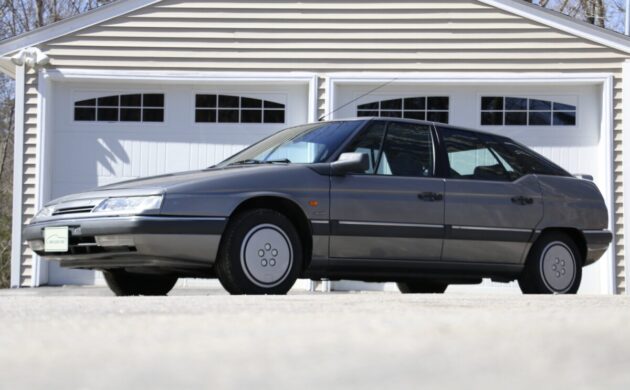
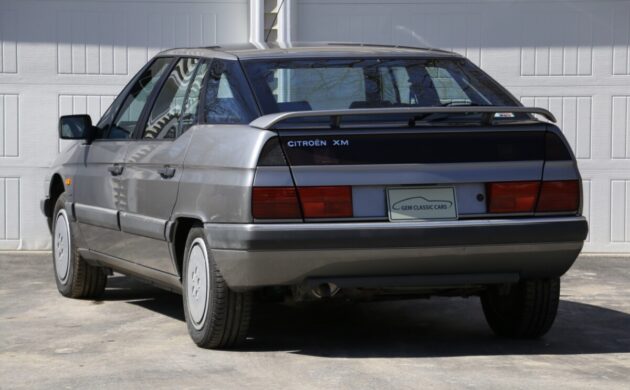
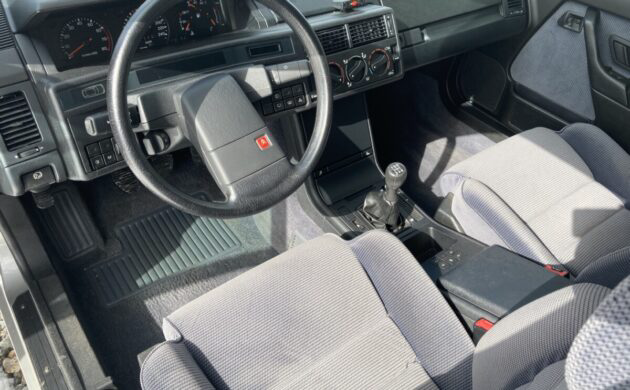
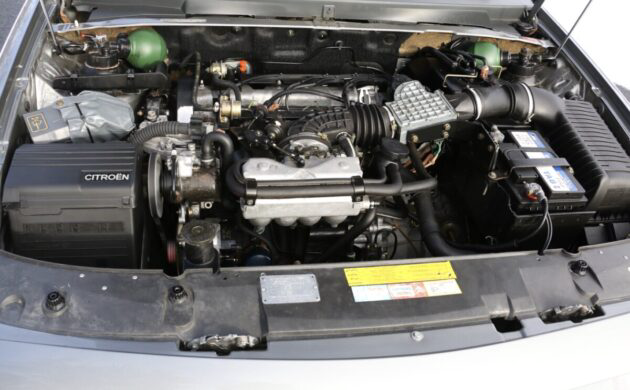
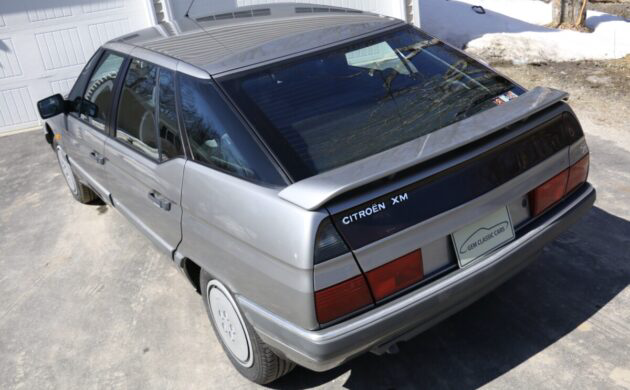


Interesting photos RE: showing the different suspension settings-the driveway pictures in particular.
A niche car but this one is incredibly well looked after it appears. If you’re a knowledgeable gearhead with a taste for something very French this should be yours.
This car does not have the PRV6 engine. It has the 2.0 liter 4-cylinder. I also think since this is the base model it has the mechanical hydro pneumatic system and not the hydractive set up. That is probably a good thing considering electronic components might be scarce if needed. Still this is a wonderful car and I have always liked the styling but its Citroen roots have been diluted by Peugeot by now. Still who can remember the classic car chase scene in Ronin with the 3.0 XM in some of the shots? I think the asking price is in line with the low miles and condition and the 5-speed gets a big thumbs up from me.
Thank you so much for the feedback, alphasud. I appreciate it. Sometimes it doesn’t matter how long I look at a photo, the obvious slips under my radar. You are spot-on about the engine, and I’ve corrected the article to reflect that. The suspension is a mystery because several sources contradict each other on the subject. It would definitely be worth discussing it with the seller because it could impact the car’s value. Otherwise, I hope you continue enjoying our articles, because I certainly enjoy writing them.
I do enjoy the discovery and the articles brought to this site and appreciate the effort that goes into the write ups. My love for cars makes me a sponge when it comes to history and technical details. I enjoy getting schooled by individuals who comment on this site and if I’m wrong on a comment I appreciate others setting it straight.
A friend of mine in Germany had one and loved it. He drove it for many yeaes without any issues.
French fries, yes! Citroen, no.
Irony alert. My ex FiL ran two of these into the ground and they now sit on his farm rotting away. He bought the diesel versions and ran them on ‘fish & chip’ shops waste oil. Nought to sixty was about ten minutes and exhaust stank of aforementioned waste oil. “Cheap as Chips to run”, he would proudly boast!
Possibly the biggest non opening phony “vent” window on each front door i have yet seen. No American car buyer in the ’60s would stand for THAT – many went berserk when the openable vent windows disappeared! on many american cars in the late ’60s. If GM could make the astrovented curved glass roll down on a ’70s f-body door, then Citroen would have been able to here – or at least make the darn things openable!
Why? You allude to car buyer of the 60’s and a design feature of the 70’s, but this is a car for the 90’s – when flow-thru dashboard vents made the old vent windows redundant!
So why put a phony one there instead of continuous glass? Such a big phony vent makes it less convenient when you want to pay a toll or use a drive thru. & clautrophobics would not be happy either. & hopefully you can fit thru the openable part – if the car is under water & the doors won’t open! & on cool comfy days there is a lot less window to roll down. BTW, 60’s astroventilation also allows direct from the outside(on non a/c cars) air to flow through the car with windows closed, providing the car was moving.
In the 90s, only 1 American car(1992–1999 Bonneville – & its sister division versions) out of many many American cars had a phony vent window – & it was a lot smaller than the one on this Citroen.
Oddly, all prior & all succeeding gens of Bonneville did not have the phony vent window.
Glass is heavy & i think Citroen wanted to use the lightest cheapest up & down window mechanisms & i bet there are plastic parts on the regulator, like on the troublesome ones on the 3000gt.
Fixed front quarter windows (what you call “phony vent” windows) usually exist for one or both of two reasons:
1) To allow the moving window to lower fully into the door cavity — which can also be a matter of styling, if allowing the entire glass above the beltline to lower into the door would require ugly styling solutions, e.g. changing the B-pillar angle or thickness, door shutlines, body-side contour, beltline (where the body and glass meet) and/or glass tumblehome (how much it leans in toward the roof);
2) To make a smoother aerodynamic transition from the windshield across the A-pillar and around to the side glass.
Probably both factors apply to the XM. Bertone would have strenuously objected to having their name attached to an uglified design, and note how the strip between the fixed and moving glass points pretty much directly to the bottom-front corner of the door, confirming there would be no room in the door forward of that for more glass fully lowered.
I had an 89 XM with the V6 and hydraulic suspension. It was interesting and I didn’t have any issues with it, but I much preferred the Audis/BMWs/Mercedes of that era in every respect. I would even rather have another Peugeot 405 M16 than an XM. Not that I dislike Citroens…I do have a Traction Avant 15/6.
What didn’t you like about the XM? I agree it’s hard to beat German cars of that era. I really enjoy my 92 Mercedes 400E. I purchased a 88 CX turbo2 last year but my first love would be to own a DS.
I had a DS 21 back in the ’70s. I could not believe cars could be so comfortable. Drove it through the Blizzard of ’78 when even Jeeps were getting stuck or sideways. I later got another Citroen, an Ami 6. Not such a good car as the DS series
I owned one of these when I lived in France. I would say that it was great on the Auto routes however it was at its best wandering through all the narrow “D” roads and vineyards in the Languedoc. The hydro-suspension allowed you to raise the body enough to clear all sorts of natural road debris (rocks etc) while still being amazingly comfortable.
Probably could not get it registered in California due to emissions restrictions.
Great cars. Despite the complexity, Citroens of this era are pretty reliable. Not sure I would run one in the USA, though!
I agree. Between the complexity and the lack of a proper service network, there’s no way a car like this would survive here in the USA.
Very cool… but who could one find to work on it?
I completely agree. I love it, AND I can afford it. BUT….I’m not a mechanic and although I live in the Dallas-Fort Worth area, I have no idea if there is a good mechanic anywhere close to me or even anywhere in North Texas who could repair it. And I’m not going to buy it without knowing that. There are many other cars, classic and not so classic, I like that I can get fixed with very little trouble or no trouble at all. I’m not Jay Leno so I’m going to pass.
Why a new timing belt at a mere 10k miles?
AGE of the original belt?
Belts perish. The change interval is 75 000 kms or 5 years whichever comes first.
Lovely looking car. IMHO, it’s the best looking car produced by Citroën since the DS.
“…since the DS….”
agreed, but also DS was tops of their
offerings. Should have stopped there?
To me this car looks pretty homely. All those incongruous angles and a stubby little deck with a spoiler on it. I’m sure if I read some books about these cars I’d appreciate them but with that big rear end it looks a little like a bottom heavy first generation Taurus.
Hi, I am the one selling this car and I do confirm it’s a normal hydrolic and not the hydractive. And no AC unfortunatly but original 10k miles documented.
I knew a guy at work who bought a Cit to be different. His had low mileage too, spent more time at the dealership getting something fixed…. c’est la vie
The most parallel here in the US, for offering an unconventional, but ahead of its time, car was the ’34 Chrysler/DeSoto Airflows. Beauty is in the eye of the beholder, of course, but Ford got away with an unconventional design at the same time with the Zypher, but the everyday Ford, sold in the hundreds of thousands had a modified version of the same styling, so there were many on the roads and it was “conventional” enough that it sold, and as did the Divco delivery truck, and the Burlington railroad’s first diesels, which copied the Airflow, but they were not passenger cars.
So, a base XM with the 110 hp 2.0. That’s a bit unfortunate as the 122 hp version is more of an improvement than what the small hp difference suggests. Otherwise for sure one of the nicest XM I have seen.
I had a new 1990 122 hp Confort and liked it quite a lot. What do I remember?
1/ They are better to drive than what the small engine suggests. It’s reasonably torquey so moves okay. The 122 hp had better throttle response but both 4-cylinders will do quite well. And they are a lot more reliable than what the V6 variants were.
2/ Loved the seats and the suspension. Very comfy car. Also practical with the big hatch and folding rear seat.
3/ The view out through the windshield was a bit odd as you can’t see anything of the hood. It just seems like the car ends at the base of the windshield.
4/ I wouldn’t miss the active suspension. It just made the car unnecessarily stiff and didn’t have the functionality of the later Xantia Activa cars where the suspension makes the car lean in to turns almost like a motorcycle. This basic setup is just fine. But the XM is always quite a bit stiffer than the DS and CX. Still comfy but not as unique of an experience.
5/ Just generally a lot less complex design than the DS and CX. I would suspect that it is easier to maintain as a lot of parts are shared with various Peugeot models.
What keeps these cars from selling imho is the lack of a dealer network. Otherwise they seem pretty nice. I liked the thought of a Maserati engine under the hood better than this engine but oh well.
By this era Citroen no longer owned Maserati, so little chance they would have fitted a Maserati engine as they did with the SM, not to mention the transverse drivetrain complicating matters further whereas the SM was longitudinal.